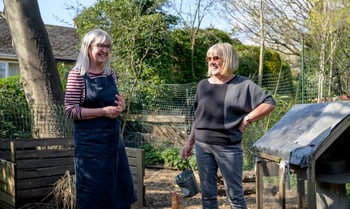This resource is also available in French. Click here to access the French version.
 By now, it is widely understood that climate change is a transversal issue that has the power to affect many areas of our collective life: from our health to the soundness of our infrastructure, from pre-existing issues such as poverty and homelessness to food security and beyond. Nevertheless, much of the work currently being done in these areas continues to be carried out in siloes rather than being integrated through the collective harnessing of our many resources and competencies in these varied, yet connected, domains. A just and equitable transition to a low-carbon future requires climate action that centers the lived experiences of systematically excluded populations, those directly impacted by changing industries, and those most vulnerable to the impacts of climate change. Community groups and citizen-led climate initiatives are powerful local nodes that connect local lived experience with community engagement on a larger scale.
By now, it is widely understood that climate change is a transversal issue that has the power to affect many areas of our collective life: from our health to the soundness of our infrastructure, from pre-existing issues such as poverty and homelessness to food security and beyond. Nevertheless, much of the work currently being done in these areas continues to be carried out in siloes rather than being integrated through the collective harnessing of our many resources and competencies in these varied, yet connected, domains. A just and equitable transition to a low-carbon future requires climate action that centers the lived experiences of systematically excluded populations, those directly impacted by changing industries, and those most vulnerable to the impacts of climate change. Community groups and citizen-led climate initiatives are powerful local nodes that connect local lived experience with community engagement on a larger scale.
As they develop their local climate plans, countless communities across Canada have started exploring and implementing integrated and intersectoral approaches to identifying and iterating on solutions, even as the necessary financial supports for this work are still largely missing. Just as structural climate interventions are not the responsibility of a single actor alone, collective climate action itself cannot be the responsibility of any single organization, group, or person. Yet it is challenging for any such entity alone–particularly for small grassroots groups and local non-profits–to trust that they don’t have to do it all alone.
Many non-profits, for example, are faced with the challenge of sustaining their work in the long-term, particularly as project-based funding cycles and ongoing fundraising needs require a significant amount of dedicated resources that, in turn, constrain the nature and reach of their efforts. Similarly, many grassroots groups find it hard to grow and scale into deeper community-wide work as they often lack the legal structure to apply for funding and support their work long-term.
Tamarack Institute has been championing Collective Impact work to reduce poverty across Canada over the past two decades. It is through deep community engagement and by bringing together local residents, organizations and groups, institutions and governments to work together around a common agenda, that the Collective Impact approach helps to shift policy and systems. We cannot fight the climate crisis alone and uniting all the different actors in a community is a way to advance climate action and equity that includes everyone.

Another thing we know at Tamarack is that community groups and organizations working on climate action need a stable source of funding to kick-start and sustain the collective impact work. Governments and the philanthropic community hold the potential to collectively create regional funding pools to provide much-needed seed funding to kickstart collective impact work for community climate transitions.
For now, paving the road to a sustainable future requires that local climate leaders and community groups be frugal and pioneer their way forward. To dive deeper into how to launch a community climate startup, which organizational structure to use, and how to build out a business plan and a budget, read our Climate Entrepreneurship Guide.
Dive deeper:
- In 2021, Tamarack launched its first Community Climate Transitions Cohort supporting 19 trailblazing communities across Canada in creating a path for collective climate action. Read about their emerging work to learn more about how they’ve been implementing the Collective Impact approach and fostering collaborations in their community.





